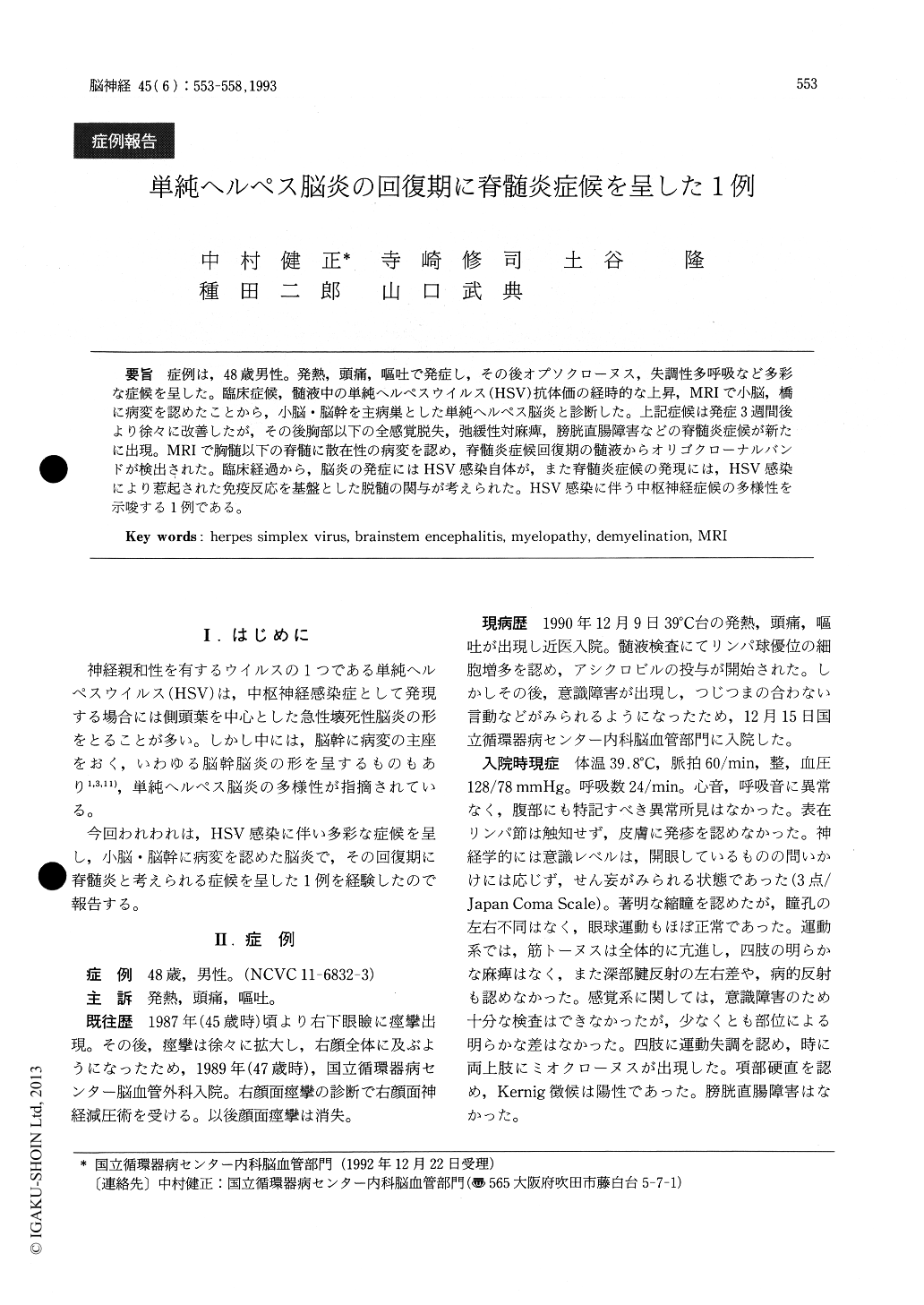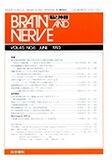Japanese
English
- 有料閲覧
- Abstract 文献概要
- 1ページ目 Look Inside
症例は,48歳男性。発熱,頭痛,嘔吐で発症し,その後オプソクローヌス,失調性多呼吸など多彩な症候を呈した。臨床症候,髄液中の単純ヘルペスウイルス(HSV)抗体価の経時的な上昇,MRIで小脳,橋に病変を認めたことから,小脳・脳幹を主病巣とした単純ヘルペス脳炎と診断した。上記症候は発症3週間後より徐々に改善したが,その後胸部以下の全感覚脱失,弛緩性対麻痺,膀胱直腸障害などの脊髄炎症候が新たに出現。MRIで胸髄以下の脊髄に散在性の病変を認め,脊髄炎症候回復期の髄液からオリゴクローナルバンドが検出された。臨床経過から,脳炎の発症にはHSV感染自体が,また脊髄炎症候の発現には,HSV感染により惹起された免疫反応を基盤とした脱髄の関与が考えられた。HSV感染に伴う中枢神経症候の多様性を示唆する1例である。
A 48-year-old male was admitted to our hospitalbecause of fever, headache and vomiting.
At admission, the level of consciousness was depressed (drowsy) with slight confusion. Extreme-ly miotic pupils, nuchal stiffness, ataxia and myo-clonic movements of both upper limbs were obser-ved. The eye movements were almost normal and there was no definite limb weakness or sensory impairment. A few days after admission, his level of consciousness further decreased, and opsoclonus, ataxic breathing and intestinal paralysis appeared. The body temperature fluctuated remarkably rang-ing from 33.0℃ to 39.0℃.
The cerebrospinal fluid (CSF) examination re-vealed lymphocytic dominant pleocytosis, incre-ase of protein and decrease of glucose. Enzyme -linked immunosorbent assay (ELISA) showed in-creased antibody (IgG) to herpes simplex virus (HSV) in both serum and CSF. The antibody in CSF further elevated at the later examination. Magnetic resonance imaging (MRI) demonstrated high signal intensity areas mainly in the cerebellum and sporadically in the supratentorial subcortical white matter on T2-weighted images. Administra-tion of Gadolinium-DTPA also revealed an addi-tional lesion in the pons.
From these findings, he was diagnosed as herpetic encephalitis involving the brainstem and the cere-bellum, and acyclovir was administered. Although his initial symptoms and signs started to recover three weeks after admission, he newly developed complete flaccid paraplegia, dysuria and sensory disturbance with the spinal cord level of the 4th thoracic segment. The oligoclonal IgG bands were detected in the cerebrospinal fluid of the convales-cent stage.
Considering from the clinical course that the myelopathy developed in the convalescent stage of the encephalitis and other findings, not direct damage by HSV, but other mechanisms, probably immune reactions, may play a role in developing the myelopathy. That is to say, in the present case, it is presumed that HSV directly damaged the brainstem and the cerebellum, and later immune reactions activated by HSV infection caused the myelopathy.

Copyright © 1993, Igaku-Shoin Ltd. All rights reserved.


